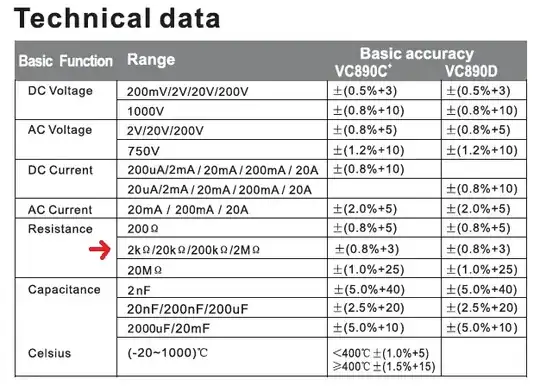I hope this doesn't get people's eye rolling as a very rudimentary question...
Here goes. I need a very, very precise resistor divider, say a 1/11 ratio. It doesn't really matter the ratio chosen. Just as long as it is known & very precise. It so follows both R1 & R2 needs to be in very, very tight tolerances. My approach is to simply parallel SMD resistors so it adds up R1 & also parallel resistors into R2.
Starting off:
$$R(1 + t_j) = R + R t_j$$ where \$R\$ is the ideal value of the resistor & \$R t_j\$ is the tolerance.
By some light math we should be able to show parallel resistors: $$(\sum_{j=1} ^n (R(1 + t_j))^{-1})^{-1}$$
Let \$\bar t \$ exist & be the average tolerance: $$\Rightarrow (\sum_{j=1} ^n (R(1 + \bar t))^{-1})^{-1}$$
$$\Rightarrow (\frac{1}{R(1 + \bar t)} \sum_{j=1} ^n 1)^{-1}$$
$$\Rightarrow (\frac{n}{R(1 + \bar t)})^{-1}$$
$$\frac{R}{n} + \frac{R \bar t}{n}$$
Parallelizing narrows it's tolerance with \$\frac{R \bar t}{n}\$, even if it lowers it's ideal resistance of \$\frac{R}{n}\$.
So, for example, having made my R1 with (n = 16) 1k ohm resistors with 0.05% individual tolerances, the total narrower tolerance is 0.003125%. For R2, if I used (n = 16) 10k ohm resistors with, also, 0.05% tolerance, the narrower tolerance should be, likewise 0.003125%.
Then, I took a handful (not all, but a handful) of these SMD 1k & 10k ohm resistors & individually measured them. For the 1k ohm, all measured 1.002k ohm in the 2k range of my multimeter. As for the 10k ohm, all measured 10.00k ohm in the 200k range of my multimeter. I guess the tolerance ranges are hiding behind the resolution of my multimeter's ranges.
Parallelizing 16 SMD resistors via reflowing them into the PCB, I was expecting 62.625 ohms (1.002k ohm/16) & 625 ohms (10.00k ohm/16) both with tolerances of 0.003125%, below the resolution of my multimeter. I'm sure. So it's possible it was accuracy issues when I measured 63.4 ohms & 631 ohms. Although, these are deviations of 1.238% (|63.4 - 62.625|/62.625) & 0.96% (|631 - 625|/625). When I looked up the accuracy specs off the multimeter in question (I must've lost the manual it came with), those are above the multimeter's accuracy limits of ±0.8% + 3.
Or, perhaps I'm misreading this. What's 3 in "±0.8% + 3"?
Btw, in series:
$$\sum_{j=1} ^n R(1 + t_j)$$ $$\Rightarrow nR + \sum_{j=1} ^n t_j$$ Averaging, let: \$\bar t = \frac{\sum_{j=1} ^n t_j}{n} \Rightarrow \sum_{j=1} ^n t_j = n \bar t \$ $$nR + nR \bar t$$
